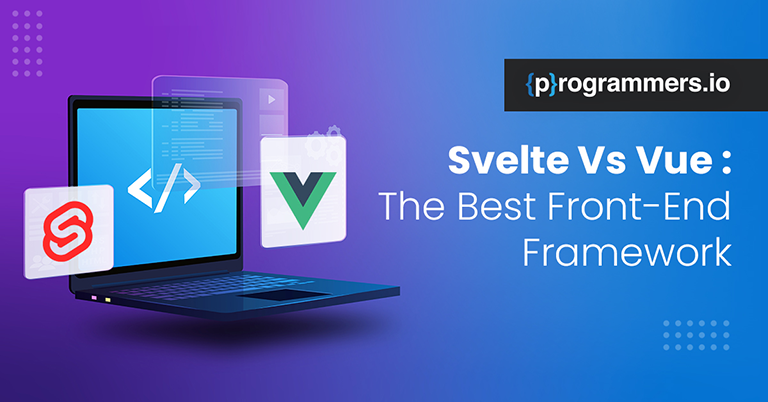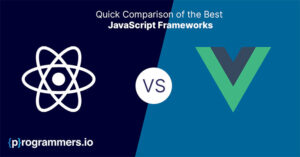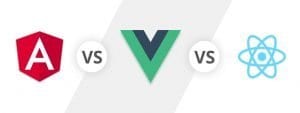A good user interface can increase your conversion rates by as much as 200%. A good user interface is one that is easy to use and loads intuitively—one that you can create by using a reliable JavaScript frontend framework for your application.
But what are the JavaScript frontend framework options you have? There are several options to choose from, but the most popular ones include React.js, Angular, Vue.js, Next.js, and Svelte. Most of the comparisons of JavaScript frontend frameworks have focused on React.js, Vue.js, and Angular. But, here, we will look into the less talked about comparison: Svelte vs. Vue.
These two frontend frameworks for JavaScript provide customers with an excellent user experience and are fast becoming a topic choice for web developers. But which of these JavaScript frameworks should you choose for your project? It depends on several factors, including how each framework works and its pros and cons.
So, without further ado, let’s start the Svelte vs Vue comparison to help you choose the correct option for your project.
Overview of Svelte and Vue Frameworks
Before we get into the Svelte vs Vue, it is important to understand each framework and how it works. Once you understand the Svelte and Vue JavaScript frontend frameworks, the pros and cons of each framework and the side-by-side Svelte vs Vue comparison will make sense to you. Let’s not wait any more time and start the overview of the Vue framework.
What Is The Vue.JS Framework?
A Vue JS development company working on your project can build single-page applications (SPAs) and user interfaces using the frontend and open-source JavaScript library Vue. JS. The brainchild of Evan You, this frontend framework was launched in 2014.
It has several advanced functions that allow you to meet the requirements of complex apps when you hire Vue.JS developers to work on your development project. Some of the advanced capabilities available with Vue.JS to the developers you hire include build tooling, state management, and routing.
The experience of the developers you hire is important but not vital when you’re working with the Vue.JS framework, as it is a user-friendly and lightweight platform. The easy-to-integrate and simple MVVM architectural platform makes it possible to provide users with a seamless experience.
In some ways, Vue.JS is similar to React and Angular but it outperforms these two frontend frameworks in accessibility and simplicity. Developers will find it incredibly easy to learn and use this JavaScript frontend framework as it comes with lightweight solutions enabled by the framework’s adapting capabilities.
Vue.JS is the perfect choice if you’re looking to make your workflows more efficient by using the advanced features and performance offered by this JavaScript frontend framework.
How Does The Vue.JS Framework Work?
You now understand what Vue.JS is but you would still want to know how it works. Here is a simple explanation. The Vue.JS frontend framework makes changes and updates to the state by using the Virtual DOM.
You can support two-way and one-way data binding—also called reactive two-way binding— using Vue. JS. It allows you to easily make changes to the data between a component within the framework and its template.
Another feature of this frontend framework is that it has a vivid ecosystem. You don’t have a mobile framework at your disposal when working with Vue.JS but you can use frameworks like Ionic, NativeScript, or Quasar to build hybrid mobile applications.
JSX is also used by the framework to import and easily manage custom components. Also, you can apply effects for transition as the Vue.JS framework offers several options for it. These include animations and CSS transitions. You can also have features such as JavaScript hooks, custom classes of transition, and transition wrappers at your disposal.
What Are The Popular Vue.JS Components?
Vue.JS has several components, but the most popular ones include Vuetify, Element UI, and Bootstrap. Vuetify is a great tool for developers who want to create reusable and clean components that can function seamlessly with SSR or Server-Side Rendering.
People often see Vuetify as the unofficial framework for creating material design in Vue. JS. It is one of the reasons for its high rating on GitHub. Another reason for this component’s popularity includes its vibrant community where more than twenty plugins have been added by hundreds of users.
Another great component of Vue.JS is Element UI. It is an active library with more than five hundred contributors who also provide support to those needing it. A major benefit of this component for developers is that they can use it to create an immersive and eye-catching user interface (UI).
The third and final component on our list is Bootstrap Vue. JS. It is inspired by the Bootstrap library and features a kit for user-interface. You can use this kit to utilize Bootstrap v4 to build mobile-first applications that are also responsive. You will find a grid system and many themes and components in this kit.
When To Use Vue.JS?
You will have a better idea of this after you go through the pros and cons of this frontend framework and also do a side-by-side Svelte vs Vue comparison. However, there are some specific situations where using Vue.JS makes perfect sense. One of them is when you want to use this framework to avoid adding complexities to the coding for your application.
Vue.JS is a great choice if you want an architecture that distinguishes logic from view. You can use this capability to launch small projects or build a single-page application (SPA). This JavaScript frontend framework is also a good option if you want to access features that make things easier for developers, such as code-splitting and tree-sharking.
What Is The Svelte Framework?
You can create websites and web applications that users find interactive by using the JavaScript framework Svelte. This frontend framework has many of the features you get with Vue and React, so building immersive web applications with it should not be a problem.
The framework is the brainchild of Rich Harris, who launched it in 2016 with the aim of redefining frontend development. He wanted to increase its speed and efficiency, which led to the creation of a toolbox for developers to build dynamic UIs that provided users with a seamless and intuitive experience.
One of the things that set Svelte apart from other popular JavaScript frontend frameworks is that it maximized the overhead associated with them. It accomplishes this through its lightweight design capability.
Developers can create highly scalable web applications that perform incredibly well in this way. The U.S.P of the Svelte framework is that it can help developers to build ultra-fast applications.
How Does The Svelte Framework Work?
You would want to know how it works how the Svelte framework works, just like you did with Vue.JS. Firstly, the view, logic, and template in a Svelte app are separated using the principles for the MVC architecture. The purpose of this is to ensure that multiple developers working on a project can do their work simultaneously.
This frontend framework combines TypeScript, CSS, and HTML you create with it into plain JavaScript. Another reason for using this JavaScript framework is that it does not require too many resources to build a virtual DOM. The result of this is that the application you create with the Svelte framework loads more quickly.
What Are the Popular Svelte Components?
Svelte has several components, but the most popular ones include Svelte-flow, Material UI, and Carbon Components.
The Svelte-flow component is powered by the user interface (UI) component of the framework, and it makes the web development process faster for developers. Developers working with this framework can choose from a few different modes, including navbar, dark modes, cards, modals, and buttons.
Another popular Svelte component is Material UI. It includes components written using TypeScript. SASS is used to style the Material UI, which comes with a plethora of utilities and widgets that developers can use to build custom components for user-interface as per the requirements.
The third and final Svelte component on our list is Carbon Components. The open-source Carbon Design System from IBM comprises over twenty charts, seven hundred pictograms, and seven hundred icons that can help you in creating a user-friendly app interface.
When To Use the Svelte Framework?
A side-by-side Svelte vs Vue comparison will provide you with a better idea of this. However, one situation where using this framework makes perfect sense is when you want a JavaScript frontend framework that is simple to use.
The simplicity of this framework makes it a great choice for small-scale development projects. Even developers with very little experience of using JavaScript frontend frameworks will find it easy to use due to its simple coding syntax.
The Pros and Cons of Svelte vs Vue
Before we do a side-by-side comparison of these two frameworks, let’s quickly go through the pros and cons of Svelte and Vue, starting with the latter.
Pros and Cons of Vue.JS
Here are the pros and cons of the Vue frontend framework:
Pros
Here are the advantages of Vue JS:
- Features excellent documentation and an extensive library
- A great choice for complex web app interfaces and small one-page applications due to its adaptability
- Features a simple syntax and many templates that facilitate a faster development process
Cons
While there are several benefits of using the Vue frontend framework, there are a few drawbacks to consider as well. These include:
- Code complexity that affects flexibility is likely due to the sheer number of options available
- Knowledge exchange is limited since the size of community is much smaller than other popular frameworks like React
Pros and Cons of Svelte
Here are the pros and cons of the Svelte frontend framework:
Pros
- The simple syntax makes it easier to use than other frontend frameworks
- Improves user experience by using declared variables to provide automated updates
- Optimizes performance by compiling code without using a Virtual DOM
Cons
- Like Vue.JS, the Svelte framework also has some drawbacks. These include:
- Less support than other popular frontend frameworks like Vue, React, and Angular
- Limited options for developers who want to create one-page web applications, as well as some issues with routing
Now that you know the pros and cons of Svelte and Vue, let’s do a side-by-side comparison of these two frontend frameworks for critical variables.
Side-By-Side Svelte Vs Vue Comparison
Here is a side-by-side comparison of Svelte and Vue for critical variables to help you choose the most appropriate frontend framework for your situation or project.
| Variable | Vue | Svelte |
| Popularity | Incredibly popular | Becoming more and more popular each day |
| Flexibility | Allows you to use different architecture | Offers a component-based approach that is highly flexible |
| Virtual DOM | Available | Not present |
| Syntax | Uses a template syntax with declared variables and instructions | Uses syntax with minimum markup and reactive statements. |
| Uses syntax with minimum markup and reactive statements. | Provides support for preprocessors, scoped styles, and CSS modules | CSS for styling and scoping built into the framework |
| Learning Curve | Has an easy learning curve | The learning curve can be difficult for some developers |
| Compilation | Compiles components into functions for rendering | Compiles into coding for JavaScript |
| Performance | Not as fast as Svelte | Can work incredibly fast without needing Virtual DOM |
| Security | Has several security features | No features built-in for security |
| Bundle Size | Runtime overhead increases bundle size | Optimized compile-time results in smaller bundle size |
| Tooling | Features DevTools and other comprehensive ecosystems for tooling | Features smaller ecosystems for tooling such as Sveletkit |
| Community Support | Has a large and active community | Limited community support |
| Reactivity | Use computed properties to bind data with reactive statements | Uses reactive statements create used built-in reactivity |
The Svelte Vs. The Vue comparison above covers all the variables that you need to look at to be able to make an informed choice between these two frontend frameworks. You can look at a similar comparison of Vue vs React if you’re looking to choose between these two frontend frameworks.
Why Should You Choose Programmers.io For Development With Vue and Svelte Frontend Frameworks?
If you’re looking to find developers who have the expertise and experience of working on development projects involving the Vue or Svelte JavaScript frontend frameworks, then Programmers.io can provide you with them.
We can connect you with developers with varying expertise and experience, including those who know the ins and outs of the different JavaScript frontend frameworks, including Vue and Svelte. They can provide you with the knowledge, guidance, or technical assistance you need to complete your development project on time and affordably.
Conclusion
You have several JavaScript frontend frameworks to choose from, but Vue.JS and Svelte are two that stand out. You can choose between these two frameworks by considering the pros and cons of each framework outlined above and the variables in the side-by-side comparison. It will help you to make the right choice.




